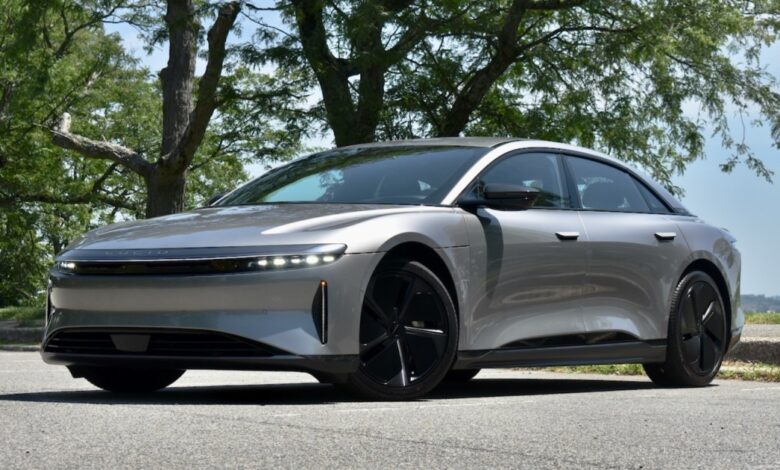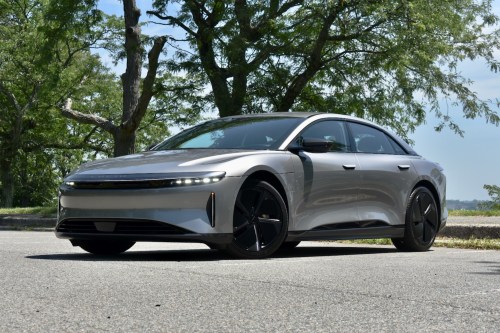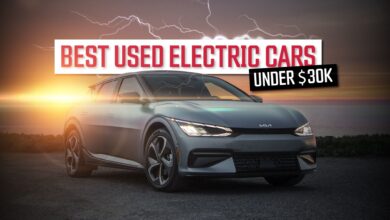2024 Lucid Air lineup drive: the power of choice


If you’re only going to sell one car, you’d better make it count.
The Lucid Air electric car finally took flight in 2020 after years in financial limbo. While Lucid plans to launch an SUV called the Gravity and a line of smaller, more mainstream models, the Air remains Lucid’s sole product nearly four years after its launch. The Air has evolved in that time, adding multiple configurations that allow this one car to fill several niches.
Lucid has changed the Air lineup multiple times since the car’s launch, and is doing it again for the 2024 model year. The lineup now consists of the base rear-wheel drive Pure, all-wheel drive Touring, maximum-range Grand Touring, and maximum-performance Sapphire.
This reshuffling was as good of an excuse as any to revisit the Air and see how the four versions compare. Digital Trends recently had the opportunity to do exactly that, driving all four Air models back-to-back on scenic roads and highways in the Hudson Valley just outside New York City.
Pure enjoyment
If you’re looking for a fast and luxurious EV with road-trip worthy range, the Lucid Air Pure base model may be all the car you need. The Pure loses its all-wheel drive option for the 2024, but the remaining rear-wheel drive version starts at $71,400 and extracts 419 miles of range from its 88-kilowatt-hour battery pack. That’s impressive considering that a Tesla Model S requires nearly 100 kWh of battery capacity for 402 miles of range.
The single-motor Pure is the least-powerful Air model, but still generates 430 horsepower and 406 pound-feet of torque. That will get this 4,564-pound sedan from zero to 60 mph in a Lucid-estimated 4.5 seconds, It has a top speed of 124 mph. We also think the Pure is a lot more fun than its more powerful Touring and Grand Touring siblings.
We guided the Pure with the precision of Rebel pilots on the Death Star trench run.
This rear-wheel drive model feels more eager to attack corners, in part because the unpowered front axle really made the steering come alive. This isn’t a small car, but we were able to guide it down twisty roads with the precision of Rebel pilots on the Death Star trench run. We didn’t exactly miss the extra power of the other Air variants when the road straightened out, either. The Pure is plenty quick.
The Pure also doesn’t give up much when it comes to creature comforts and tech. It has the same 34.0-inch display as more expensive Air models, with most controls routed through a lower touchscreen that Lucid calls the Pilot Panel. Wireless Apple CarPlay is supported, but Lucid still doesn’t offer Android Auto connectivity. Synthetic upholstery is standard instead of real leather, but that’s for reasons of sustainability rather than cost.
More power, less urgency
The Touring is another carryover model, but with the deletion of the dual-motor Pure from the lineup for 2024, it’s now the least-expensive way to get an all-wheel drive powertrain in an Air. Rather than just a sop for snowbelt customers, though, the Touring is more about splitting the different between the Pure and Grand Touring models.
The price increases to $79,400 while output jumps to 620 hp and 885 lb-ft of torque, getting the Touring from zero to 60 mph in 3.4 seconds and on to a 140 mph top speed. The Touring has a larger 92-kWh battery pack, but range drops slightly compared to the Pure, to 411 miles.
The Air Touring emphasizes smoothness and serenity rather than sportiness.
Despite being quicker than a Porsche 911 Carrera, this is a laid-back car. On the highway, it lives up to its Touring name with ride quality that makes exploiting this EV’s generous range an attractive prospect. The Touring wasn’t caught out by twisty roads, either, but the emphasis seemed to be more on smoothness and serenity than sportiness.
In addition to feeling less lively than the Pure, the Touring asks buyers to accept that they’re mostly paying for all-wheel drive and quicker acceleration. We didn’t see the Touring cockpit as a huge upgrade over the Pure cockpit, and equipment levels are fairly close between the two. The interface and list of standard driver-assist features are essentially the same. The latter covers the bases, with expected features like adaptive cruise control and blind-spot monitoring, but Lucid leaves more advanced features on the options list.
Reputation maker
The Lucid Air Grand Touring is a car that headlines are made of. With 516 miles of range from a 112-kWh battery pack, it is the longest-range EV currently on sale. It’s also the fastest-charging Air variant, able to recover 200 miles of range in just 12 minutes of charging at a suitably powerful DC fast-charging station, according to Lucid. However, the price climbs steeply to $111,400.
For 2024, Lucid eliminated the previous 1,050-hp Grand Touring Performance, leaving the standard Grand Touring with “only” 819 hp and 885 lb-ft of torque, enabling a zero to 60 mph time of 3.0 seconds and a 168 mph top speed. That’s probably just as well. The 0.4 second difference in zero to 60 mph acceleration between the Touring and Grand Touring is hard to notice without a stopwatch.
The Grand Touring is the most user-friendly 819-hp car you’re likely to encounter.
There isn’t much to distinguish the Touring and Grand Touring models when it comes to handling, either. The Grand Touring adopts the same laid-back attitude as the less-powerful Touring model, which is actually a bit funny considering how much power is on tap. The specs say Ferrari, but the driving experience says Rolls-Royce. The chassis seems set up to manage the power rather than exploit it. That does make the Grand Touring the most user-friendly 819-hp car you’re ever likely to encounter.
Inside, the Grand Touring didn’t feel very different from the Pure and Touring models, although that’s largely because Lucid chose to keep interior fittings consistent throughout, rather than cheap out on the lower-level grades. The Grand Touring’s 516 miles of range is its raison d’etre. It’s a showcase for Lucid’s ability to engineer an efficient EV, and a powerful argument against EV naysayers fixated on range anxiety.
A gem of a performance car
The Sapphire is Lucid’s answer to the Tesla Model S Plaid, and like the Plaid, it uses a tri-motor powertrain. A single front motor and dual rear motors combine for a numerically satisfying 1,234 hp, as well as 1,430 lb-ft of torque. The performance figures are predictably impressive: zero to 60 mph in 1.8 seconds, a quarter-mile time of 8.9 seconds at 158 mph, and a 205 mph top speed. A 118-kWh battery pack provides 427 miles of range — but probably less if you drive the Sapphire as intended.
This is more than just an Air Grand Touring with an extra motor, though. Upgrades like unique suspension tuning, carbon ceramic brakes, and staggered wheels (20-inch in front and 21-inch in back) with Michelin Pilot Sport 4S summer performance tires make the Sapphire a complete performance car that’s both competent and entertaining.
The Sapphire is impressive in part for what it isn’t. Cars with bragging-rights power outputs can still be dull to drive when you’re not using all of that power. And the drama of quick acceleration can drown out other aspects of the car, like food drenched in too much hot sauce. That isn’t the case here. The Sapphire feels as quick as the specs suggest, but the steering and suspension are as much a part of the experience. You get all of the flavors, not just the heat.
That’s because the Sapphire isn’t just about what happens when you push the right pedal. It feels remarkably delicate and precise for a big sedan, flowing through corners in a way that always makes you feel connected to the car’s movements. It’s also decently comfortable, and still has more range than any other EV currently available. The only catch is that the Sapphire costs $250,500. At that price, it needs to be this good.
Force multiplier
The Lucid Air has grabbed headlines with its world-beating range and charging speeds, but the full lineup shows that the basic Air platform has incredible bandwidth. The reshuffled lineup also provides a clearer distinction between models than the current BMW i7 or Mercedes-Benz EQS lineups, while giving customers more choices than Tesla, which has whittled down the Model S lineup to two variants. The current Air lineup acts as a force multiplier, allowing Lucid to fill as many niches as it can with just one vehicle.
Some issues can’t be addressed by tweaking power output, battery size, or price. The Air’s styling may not be for everyone, and the same goes for its touchscreen-heavy interface, which requires use of a screen to adjust the mirrors and steering wheel. The Air Touring seems to exist mostly to fill a price gap, and even the cheapest Air Pure remains firmly in luxury-car territory at a time when high prices are one of the main factors holding back EV adoption. But until more models arrive, the Air should be more than able to hold the line against Lucid’s rivals.
Editors’ Recommendations



